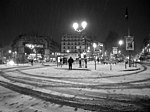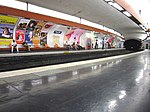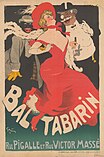Cabaret du Néant

Cabaret du Néant ([ka.ba.ʁɛ dy ne.ɑ̃], "Cabaret of Nothingness"/"Cabaret of the Void") was a cabaret in Montmartre, Paris, founded in 1892. The Cabaret du Néant was an early pioneer of the modern theme restaurant and dealt with various aspects of mortality and death. The dark theme of the cabaret included magic tricks and illusions focusing on morbid subjects. The cabaret was first established in Brussels, subsequently moved to Paris, and promoted performances in New York City. The Cabaret du Néant, along with the Cabaret de L'Enfer (Cabaret of Hell), and the Cabaret du Ciel (Cabaret of Heaven), was part of a trio of themed restaurants established at around the same time in Montmartre.
Excerpt from the Wikipedia article Cabaret du Néant (License: CC BY-SA 3.0, Authors, Images).Cabaret du Néant
Boulevard de Clichy, Paris 18th Arrondissement
Geographical coordinates (GPS) Address Nearby Places Show on map
Geographical coordinates (GPS)
| Latitude | Longitude |
|---|---|
| N 48.88282 ° | E 2.33662 ° |
Address
Boulevard de Clichy 34
75018 Paris, 18th Arrondissement
Ile-de-France, France
Open on Google Maps










